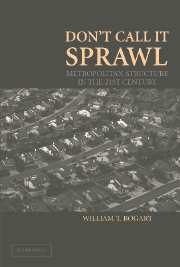Book contents
- Frontmatter
- Contents
- Acknowledgments
- 1 The World of Today
- 2 Making Things Better: The Importance of Flexibility
- 3 Are We There Yet?
- 4 Trading Places
- 5 Downtown: A Place to Work, a Place to Visit, a Place to Live
- 6 How Zoning Matters
- 7 Love the Density, Hate the Congestion
- 8 Homogeneity and Heterogeneity in Local Government
- 9 The World of Tomorrow
- Notes
- References
- Index
3 - Are We There Yet?
Published online by Cambridge University Press: 02 December 2009
- Frontmatter
- Contents
- Acknowledgments
- 1 The World of Today
- 2 Making Things Better: The Importance of Flexibility
- 3 Are We There Yet?
- 4 Trading Places
- 5 Downtown: A Place to Work, a Place to Visit, a Place to Live
- 6 How Zoning Matters
- 7 Love the Density, Hate the Congestion
- 8 Homogeneity and Heterogeneity in Local Government
- 9 The World of Tomorrow
- Notes
- References
- Index
Summary
The four-mile journey from athens to piraeus was an all-day affair in 400 bc (Hall 1998, 38) The radius for a one-day activity these days is closer to 100 miles. Thus, a metropolitan area effectively encompasses 625 times the area of classical Athens. The population of “greater Athens” in those days was about 200,000 to 300,000. Our largest metropolitan areas are about 100 times as populated, illustrating both that density has decreased and that this day's journey rule of thumb is reasonable. Interestingly, the word metropolis, literally “mother city,” originally referred to the city that was the founder of a colony. Just as the colonies of Ancient Greece had an independent life but also an ongoing relationship with their mother city, the trading places of the modern metropolitan area have a special relationship with the central city, albeit one that does not preclude their own sphere of independence.
To the Greeks, the ideal polis was self-sufficient. How, then, does one reconcile the current structure of trading places with an earlier autarkic archetype? Again, by reference to scale. The suburb of the twenty-first century includes a land area and population similar to that of a classical Greek polis. But the suburb does not encompass the entire world to its inhabitant in the way the polis did. On the other hand, the collection of trading places in a region does constitute the relevant world for most people.
- Type
- Chapter
- Information
- Don't Call It SprawlMetropolitan Structure in the 21st Century, pp. 39 - 63Publisher: Cambridge University PressPrint publication year: 2006



